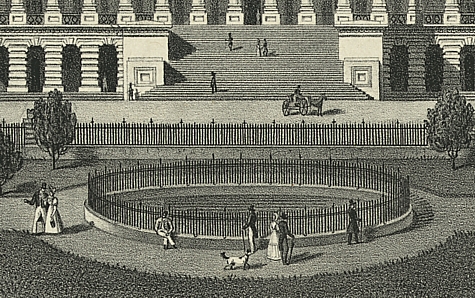 One of my current obsessions are old DC guidebooks, guides to the city published before the Civil War. They are fascinating for a number of reasons, not the least that they somehow managed to fill 300+ pages about a city that was pretty small and had almost no sights to see, in some cases by simply reprinting large swaths of the city’s laws and regulations.
One of my current obsessions are old DC guidebooks, guides to the city published before the Civil War. They are fascinating for a number of reasons, not the least that they somehow managed to fill 300+ pages about a city that was pretty small and had almost no sights to see, in some cases by simply reprinting large swaths of the city’s laws and regulations.
One result of this plethora of minutia is that many minor features that would no longer be referenced in a guidebook today are given the full treatment, and thus some aspects of the city that would otherwise be entirely forgotten are set down forever. One of those is the subject of today’s column.
When the Capitol was built, its one major failing was the lack of any running water. Although there were two pumps directly outside the Capitol, neither of them supplied water that was fit for drinking. All water for that purpose had to be carried over from a pump on New Jersey Avenue – 420 yards away.
In 1832, in order to remedy this situation, Congress appropriated money to build a pipe to the nearest good source of water, located several miles from of the Capitol
The results of this work were described in the article “The Capitol and its grounds,” published May 30, 1840 in the Farmer’s Monthly Visitor:
An oval reservoir of water, in which gold and sun fishes are sporting in numbers, has been built and enclosed with hewn free stone near the west end of the [open ground on the east side of the Capitol] and fronting the center of the Capitol. From this reservoir to which the water is brought from higher ground eastward, the water passes off in an aqueduct running directly under the Capitol to its west front, and here the water pours from a stop-cock directly into another oval reservoir in which sport the fishes. … From this reservoir the water is carried to the ground below and is lost in the small stream called the Tiber which runs towards the Potomac at the foot of Capitol hill.

Detail from the print “Elevation of the Eastern Front of the Capitol of the United States” by Wm, A Pratt. ca. 1832 (LOC)
Another article, this one published in Niles National Register, of September 16, 1837 describes the lower reservoir, which was located on one of the wide landings of the steps leading down Capitol Hill, further:
In entering the western enclosure, the first object that engaged our attention, was the new reservoir (constructed on the newly enclosed ground), in the center of which is a beautiful Jet d’Eau, which throws its pellucid and sparkling water to the height of twelve or fourteen feet, in the shape of a champagne glass, spreading all round its brilliant and pearl-like showers.
In the center of the lower reservoir was the Tripoli Monument, a statue honoring the heroes of the First Barbary War, which had been erected in the Navy Yard in 1808, then moved to the Capitol in the early 1830s.
When the Capitol was again expanded in the 1850s, the outdoor reservoirs were removed, and the Tripoli Monument moved to the US Naval Academy in Annapolis. After the Civil War, water for DC was brought in via the Washington Aqueduct and the water from local sources was used solely for those fountains that were on the Capitol grounds, which were eventually removed, as well.

I’m curious how the Summerhouse Grotto factors into this — I always thought it was built on a natural spring and just assumed that spring also supplied the Capitol building with water, too, but clearly not….